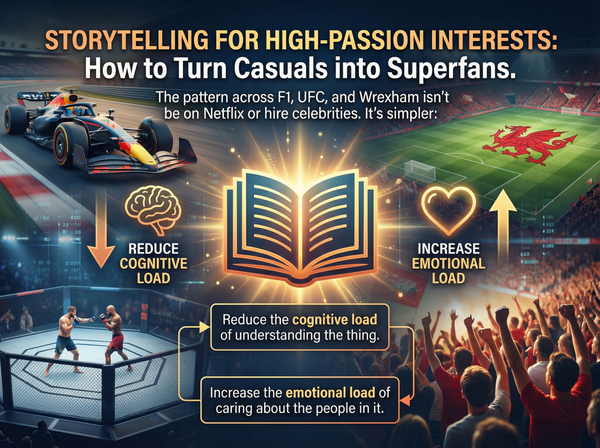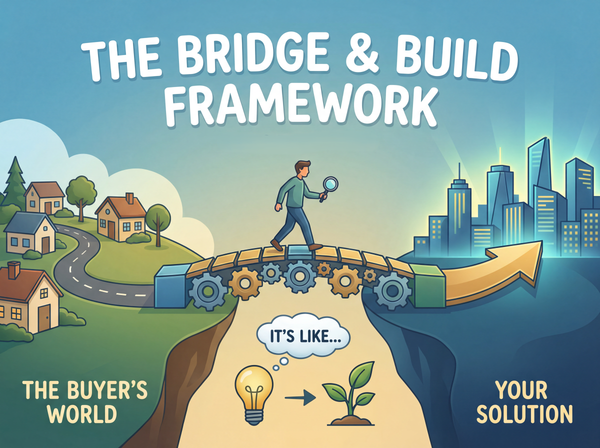Forget Ads: Why Branding (Not Advertising) Sells Your Product
Many people think of branding as something abstract and unmeasurable, involving gut feelings, logos, and colors.
But what if there was a way to think about branding that was directly tied to making money? Branding is a deliberate process with tangible outcomes that directly impacts your bottom line.
What Branding Is (and Why It Matters for Business Growth)
Branding is the act of pairing two or more things together. Your business is constantly being associated with things you say and do.
- Good branding is deliberately pairing your business with things your ideal audience likes.
- Example: Apple deliberately pairs itself with simplicity and innovation. Every ad, product launch, and store design reinforces sleek, modern, premium.
- Bad branding is pairing your business with things they dislike.
- No branding is when you're practically invisible and your exposure doesn't change people's behavior.
- Example: A local restaurant with no website, inconsistent signage, and no social media presence. Customers can’t remember its name, so it never gets repeat business.
Think of the difference between advertising vs branding like this: advertising is letting people know about your stuff, while branding is what you let them know in the advertisement.
Example: Advertising lets people know a cow belongs to someone, but branding lets them know the cow belongs to you.
A strong brand can increase the value of a business by:
- Attracting more customers
- Increasing customer lifetime value (LTV)
- Lowering customer acquisition costs (CAC)
- Boosting conversions from advertising campaigns
The Branding Cycle: From Pairing to Profit
The core of building a profitable brand is to deliberately create positive associations with your ideal customer. Here’s the process:
- Start with a Blank Slate: Your brand begins as a weak, unbranded entity that means nothing to your audience.
- Make Strategic Pairings: Associate your brand with people, values, and experiences your ideal customer likes.
- Example: Red Bull doesn’t sell energy drinks — it pairs its brand with extreme sports, daring stunts, and risk-taking culture.
- Build a Strong Brand: Over time, your brand begins to mean the thing your customer values.
- Example: Nike’s 'Just Do It' turned sneakers into a statement about ambition and achievement.
- Translate to Sales: Customers exchange money for your product because they want the outcomes and identity your brand represents.
- Example: Starbucks transformed coffee — a $1 commodity — into a $5 lifestyle accessory by pairing itself with comfort, customization, and status.
This creates a profitable cycle: the higher prices you can charge cover the cost of creating positive associations.
How to Start and Grow Your Brand
- Step 1: Figure Out Your Ideal Customer
Your ideal audience should be growing, have money to spend, be easy to target, and be in pain (meaning they desperately need what you’re selling). - Step 2: Figure Out What They Like
Identify their desires and pain points.
Example: Owners of assisted living centers might want more revenue, more customers, and fewer lawsuits. - Step 3: Associate Your Brand with What They Like
Create and distribute content that addresses their problems and provides value. This process builds trust and positive associations. - Step 4: Optimize for Maximum Profit
Continuously monitor audience response and adjust your brand’s associations. Prune what doesn’t work and add more of what they love.
Common Branding Mistakes to Avoid
- Focusing only on logos and colors instead of associations.
- Being inconsistent across platforms (website, ads, customer service).
- Ignoring customer experience — the strongest driver of brand perception.
- Copying competitors instead of creating unique associations.
The Long-Term Play: Why Branding Beats Advertising
Building a brand is a long-term investment. While direct-response advertising may provide quicker returns in the short term, branding offers compounding benefits over time:
- Higher click-through and conversion rates
- Ability to charge premium prices
- Customers who repeatedly buy from you
- Cheaper customer acquisition and higher profits
Your advertising builds your brand in the short term, but your product and customer experience build your brand in the long term.
By delivering on promises, you create a virtuous cycle of positive associations that leads to lasting business success.
Frequently Asked Questions (FAQ)
Q: What’s the difference between branding and advertising?
A: Advertising is about visibility — getting people to see your product. Branding is about meaning — what people believe when they see your product.
Q: How does branding increase sales?
A: Strong branding increases trust, reduces price sensitivity, and drives customer loyalty. This means customers buy more often, pay more, and ignore competitors.
Q: Can small businesses build a strong brand without big ad budgets?
A: Absolutely. Consistency, storytelling, and customer experience are more powerful than ad spend. Small businesses can win with authenticity and focus.
Final Thoughts
Forget the obsession with ads. Branding is the real driver of sales and long-term business growth.
By strategically pairing your business with what your ideal customers already value, you transform your product into something people want to be associated with.
Keep Crushing!
- Sales Guy


